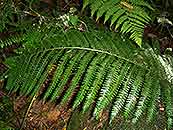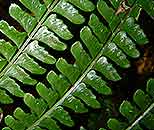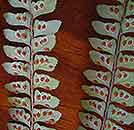Didymochlaena truncatula (Sw.) J. Sm.
Synonyms |
Didymochlaena lunulata sensu Sim |
|---|---|
Common name |
|
Description |
Rhizome erect, forming a short caudex up to 25 cm in diameter; rhizome scales 20 x 1 mm, pale to dark brown, apex tapering to a point, subentire, with a few filamentous marginal outgrowths. Fronds tufted, erect to arching, firmly herbaceous to coriaceous, up to 3.6 m long. Stipe up to 60 cm long, straw-coloured, grooved, set with reddish-brown, twisted scales up to 3 x 0.4 cm. Lamina up to 2 × 0.5 m, bipinnate, oblong-elliptic in outline, with a pinnate apical segment, not reduced at the base. Pinnae in about 20-40 pairs, alternate, spaced apart, shortly petiolate, up to 25 × 4 cm, narrowly oblong in outline, apex tapering to a point, pinnate into (26-) 35 (-40) pairs of pinnules. Pinnules up to 2.5 x 1 cm, dimidiate, almost rectangular in outline, shortly petiolate, articulated, apex rounded to truncate, lower margin entire, upper margin irregular to toothed, hairless on both surfaces, deep glossy green above, paler below. Rhachis and secondary rhachis straw-coloured with pale brown scales similar to those on the stipe. Sori 1-6(-11) per pinnule, up to 2.5 x 2 mm, broadly elliptic, sometimes deeply sunk into the lamina, set close to the upper margin; indusia up to 3.5 x 2 mm, broadly elliptic, brown with pale rims and with a narrowly elongated stalk, entire. |
Notes | D. truncatula can not easily be confused with other ferns; it has very characteristic almost rectangular pinnules with a dimidiate and entire lower margin and an irregularly crenate upper margin. |
Derivation | truncatula: cut of straight, referring to the square-shaped pinnule apices. |
Habitat | Deeply shaded moist situations in wet evergreen forest, including mist and rain forest, along margins of streams. |
Distribution worldwide | Tropical Africa and subtropical southern Afrika; also known from Madagascar, Asia and America. |
Distribution in Africa |
Angola, Burundi, Cameroon, Congo, Dem. Republic of Congo, Equatorial Guinea (incl. Bioko), Ethiopia, Kenya, Malawi, Mozambique, Nigeria, Rwanda, South Africa, Swaziland, Tanzania , Uganda, Zambia, Zimbabwe. |
Growth form |
Terrestrial. |
Literature |
|


